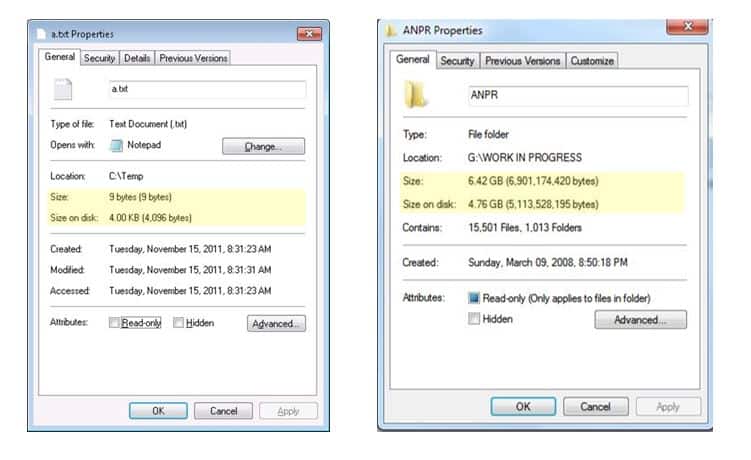Size vs Size on Disk – Why is there a difference?

Many people claim that there is a significant difference between size vs size on disk, but why does this difference exist?
When people look at the properties of a folder, file, or drive they note that properties size and size on the disk are not the same and they get confused. When you see the size of the file on the properties page, it shows the actual file size.
On the other hand, the size on the disk indicates the total number of bytes occupied by a file on a hard drive. Mostly, both these values are very close, you will notice this difference after opening the properties of a folder or a file.
Here we explain why this difference exists and whether this should be a concern.
On this page:
Size vs Size on Disk
You can find out huge differences after understanding the central concept of both these terms. So, let’s explain both these terms individually.
What is meant by file size?
When you click on the properties of a folder or file, you get the value of bytes and size. This value is an indicator of the actual bytes and size in the file. The file size is used for the measurement of the data present in the storage device. This size is presented in the form of a byte.
See also: Data capacities – smallest to largest units of information
What is the meaning of file size on disk?
The size on the disk is the indicator of how much space a file occupies on the hard disk drive. When a file is stored in a modern storage device, it usually consumes slightly more storage than the actual file. That’s the reason why you see the difference between size vs size on disk. Check the screenshot below, and it will clear your basic concepts.

Why is there a difference between Size and Size on Disk
Now the question that comes in our minds is what factors affect this file size on disk. Obviously, it depends on how your file system stores file on the storage drive. A file uses different addresses and to reduce this file system treats the number of files as a single cluster. The capacity of file size not only decided by the maximum size of a file, but it is also determined by the number of bits reserved for the information of file size. For example, the maximum file size supported by the FAT32 file system is 4,294,967,295 bytes.
Usually, in the NFTS file system, the cluster sizes range from 512 Bytes to 64 KB. It doesn’t matter how small the actual file size is because when a file is written on the hard drive, it occupies a discrete number of clusters. For example, the size of a file is 1 KB, but you save it in a file system of 2 KB clusters, it will take up 2 KB size on disk.
Similarly, when you save the 1 KB file in the file system of 32 KB clusters, it will actually take up 32 KB on the disk. Now, it’s clear that the size of a file on disk will be bigger than the actual file size. Sometimes you may get surprised as well, but it will be an exception.
For example, you may encounter a situation is which size on disk will be smaller or equal to actual file size. Remember, it will happen only when you are using the automatic compression feature that you get from your operating system. This feature compresses the file so the size on the disk will be smaller than the actual file size.
There isn’t a vast difference between the size and size on disk, however many users have claimed that a significant difference between the actual file size and size on disk exists. So, let’s try to find out the reason why there is a massive difference between the two.
What are the reasons for a large difference between Size and Size on Disk?
A hard disk consists of sectors and tracks. When you are a Windows PC user, the operating system allocates disk space for cluster units. The file system of your storage drive set different cluster sizes that affect the size on disk. When it comes to the considerable difference between size vs size on disk, you can check if there are lots of small files inside the folder and cluster size is large.
This difference will increase with the increase in the number of files because each file will waste the storage space of the drive. This size of wasted drive space keeps on adding and reaches a certain level; at that stage, the size on disk will be much larger than the actual size.
These situations occur when there are lots of small files in a folder. Along with the size on disk, it also depends on the cluster size of your file system. When you set a larger cluster size for disk, and you have a large number of files, more space will be wasted. Usually, the typical cluster size of a drive is 4 KB. For large files like games and 3D movies, you can choose 32 or 64 KB cluster size.
How to decrease the difference between Size and Size on Disk?
You can make the best use of storage devices when you manage the cluster size effectively. If you want to narrow down this vast difference, change the cluster size of the disk. You can use Windows built-in tools like Diskpart and Disk Management to change the cluster or allocation unit size. These tools can help significantly narrow down the differences between sizes.
People get confused when they see a difference in size and size on disk. It is because of the large number of small files and cluster size. Mostly the size on disk is much greater than the actual file size. Moreover, in some exceptions, this size can be less than the actual file size if your operating system uses the auto compression system. You can do this by using built-in tools mentioned-above. These tools create a partition and help reduce the allocation units and cluster sizes significantly.

